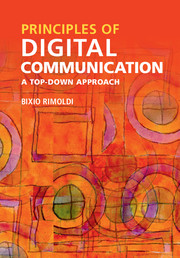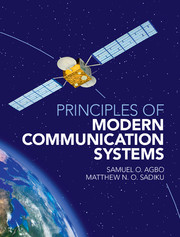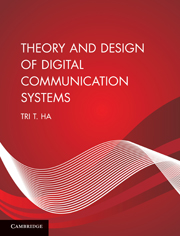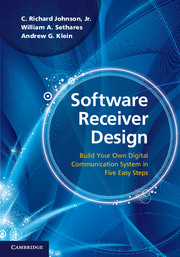Introduction to Communication Systems
$83.99 USD
- Author: Upamanyu Madhow, University of California, Santa Barbara
- Date Published: November 2014
- availability: This ISBN is for an eBook version which is distributed on our behalf by a third party.
- format: Adobe eBook Reader
- isbn: 9781316056127
Find out more about Cambridge eBooks
$
83.99 USD
Adobe eBook Reader
Other available formats:
Hardback
Looking for an inspection copy?
This title is not currently available on inspection
-
Showcasing the essential principles behind modern communication systems, this accessible undergraduate textbook provides a solid introduction to the foundations of communication theory. Carefully selected topics introduce students to the most important and fundamental concepts, giving students a focused, in-depth understanding of core material, and preparing them for more advanced study. Abstract concepts are introduced to students 'just in time' and reinforced by nearly 200 end-of-chapter exercises, alongside numerous MATLAB code fragments, software problems and practical lab exercises, firmly linking the underlying theory to real-world problems, and providing additional hands-on experience. Finally, an accessible lecture-style organisation makes it easy for students to navigate to key passages, and quickly identify the most relevant material. Containing material suitable for a one- or two-semester course, and accompanied online by a password-protected solutions manual and supporting instructor resources, this is the perfect introductory textbook for undergraduate students studying electrical and computer engineering.
Read more- Software labs build on abstract theory, and give students a taste of practical industrial applications
- Chapter introductions explaining real-world relevance of the material and a final roadmap for future R&D illustrate where communication theory sits within the bigger picture
- Integration of MATLAB code fragments and labs throughout the text allows for immediate connection of theory to practice
- Online resources include lecture slides and a solutions manual for instructors, example lab reports and code for instructors, and PowerPoint and JPEG versions of all the figures in the book
Reviews & endorsements
'Madhow does it again: Introduction to Communication Systems is an accessible yet rigorous new text that does for undergraduates what his [Fundamentals of] Digital Communication book did for graduate students. It provides a superior treatment of not only the fundamentals of analog and digital communication, but also the theoretical underpinnings needed to understand them, including frequency domain analysis and probability. The book is unusual in that it also includes newer topics of pressing current relevance like multiple antenna communication and OFDM. I strongly recommend this book for faculty teaching senior level courses on communication systems.' Jeffrey G. Andrews, University of Texas, Austin
See more reviews'This is an excellent undergraduate text on analog and digital communications. It covers everything from classic analog techniques to recent wireless systems. Students will enjoy the inclusion of advanced topics such as channel coding and MIMO.' David Love, Purdue University, Indiana
'Introduction to Communication Systems by Madhow is truly unique in the vast landscape of introductory books on communication systems. From the basics of signal processing, probability, and communications, to the advanced topics of coding, multipath mitigation, and multiple antenna systems, the book deftly interweaves abstract theory, design principles, and applications in a highly effective and insightful manner. This masterfully written book will play a key role in teaching and inspiring the next generation of communication system engineers.' Andrea Goldsmith, Stanford University, California
'This is the textbook on communications I have wanted for a while. Crisply written, it forms the basis for an ideal two-semester sequence. It nicely balances rigor, concepts and practice.' Saoura Dasgupta, University of Iowa
'This is a unique introduction to the basic principles of communication system design, with a remarkable combination of rigour and accessibility. The MATLAB exercises are expertly weaved together with theoretical principles making it an excellent textbook for training undergraduate communication systems engineers.' Suhas Diggavi, University of California, Los Angeles
'This is a valuable addition to the current set of textbooks on communication systems. It is comprehensive, and offers a modern perspective shaped by the author's research that has pushed the state of the art. The software labs enhance the practicality of the text and serve to illustrate more advanced material in an accessible way.' Michael Honig, Northwestern University, Illinois
'… an interesting introduction to communication systems that offers the readers an overview of problems related to signals and systems. It covers theoretical analysis of communications systems together with more practical approaches … It gives an appropriate background for those who have a limited knowledge in this area … [The book] offer[s] to readers a good introduction to linearly modulated signals, and different signalling constellations used for baseband and passband channels …' Jozef Wozniak, Zentralblatt MATH
Customer reviews
Not yet reviewed
Be the first to review
Review was not posted due to profanity
×Product details
- Date Published: November 2014
- format: Adobe eBook Reader
- isbn: 9781316056127
- contains: 430 b/w illus. 200 exercises
- availability: This ISBN is for an eBook version which is distributed on our behalf by a third party.
Table of Contents
Part I. Introduction:
1.1 Analog or digital?
1.2 A technology perspective
1.3 The scope of this textbook
1.4 Why study communication systems?
1.5 Concept summary
1.6 Notes
Part II. Signals and Systems:
2.1 Complex numbers
2.2 Signals
2.3 Linear time-invariant systems
2.4 Fourier series
2.5 The Fourier transform
2.6 Energy spectral density and bandwidth
2.7 Baseband and passband signals
2.8 The structure of a passband signal
2.9 Wireless-channel modeling in complex baseband
2.10 Concept summary
2.11 Notes
2.12 Problems
Software labs
Part III. Analog Communication Techniques:
3.1 Terminology and notation
3.2 Amplitude modulation
3.3 Angle modulation
3.3.1 Limiter-discriminator demodulation
3.4 The superheterodyne receiver
3.5 The phase-locked loop
3.6 Some analog communication systems
3.7 Concept summary
3.8 Notes
3.9 Problems
Software labs
Part IV. Digital Modulation:
4.1 Signal constellations
4.2 Bandwidth occupancy
4.3 Design for bandlimited channels
4.4 Orthogonal and biorthogonal modulation
4.5 Proofs of the Nyquist theorems
4.6 Concept summary
4.7 Notes
4.8 Problems
Software lab
Appendices
Part V. Probability and Random Processes:
5.1 Probability basics
5.2 Random variables
5.3 Multiple random variables, or random vectors
5.4 Functions of random variables
5.5 Expectation
5.6 Gaussian random variables
5.7 Random processes
5.8 Noise modeling
5.9 Linear operations on random processes
5.10 Concept summary
5.11 Notes
5.12 Problems
Appendices
Part VI. Optimal Demodulation:
6.1 Hypothesis testing
6.2 Signal-space concepts
6.3 Performance analysis of ML reception
6.4 Bit error probability
6.5 Link-budget analysis
6.6 Concept summary
6.7 Notes
6.8 Problems
Software labs
Part VII. Channel Coding:
7.1 Motivation
7.2 Model for channel coding
7.3 Shannon's promise
7.4 Introducing linear codes
7.5 Soft decisions and belief propagation
7.6 Concept summary
7.7 Notes
7.8 Problems
Part VIII. Dispersive Channels and MIMO:
8.1 The single-carrier system model
8.2 Linear equalization
8.3 Orthogonal frequency-division multiplexing
8.4 MIMO
8.5 Concept summary
8.6 Notes
8.7 Problems
Software labs.
Sorry, this resource is locked
Please register or sign in to request access. If you are having problems accessing these resources please email [email protected]
Register Sign in» Proceed
You are now leaving the Cambridge University Press website. Your eBook purchase and download will be completed by our partner www.ebooks.com. Please see the permission section of the www.ebooks.com catalogue page for details of the print & copy limits on our eBooks.
Continue ×Are you sure you want to delete your account?
This cannot be undone.
Thank you for your feedback which will help us improve our service.
If you requested a response, we will make sure to get back to you shortly.
×






